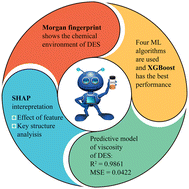Deep insights into the viscosity of deep eutectic solvents by an XGBoost-based model plus SHapley Additive exPlanation†
Abstract
Deep eutectic solvents (DESs) are emerging as novel green solvents for the processes of mass transport and heat transfer, in which the viscosity of DESs is important for their industrial applications. However, for DESs, the measurement of viscosity is time-consuming, and there are many factors influencing the viscosity, which impedes their wider application. This study aims to develop a data-driven model which could accurately and rapidly predict the viscosity of diverse DESs at different temperatures, and furthermore boost the design and screening of novel DESs. In this work, we collected 107 DESs with 994 experimental values of viscosity from published works. Given the significant effect of water on viscosity, the water content of each collected DES was labeled. The Morgan fingerprint was first employed as a feature to describe the chemical environment of DESs. And four machine learning algorithms were used to train models: support vector regression (SVR), random forest (RF), neural network (NN), and extreme gradient boosting (XGBoost), and XGBoost showed the best predictive performance. In combination with the powerful interpretation method SHapley Additive exPlanation (SHAP), we further revealed the positive or negative effect of features on viscosity. Overall, this work provides a machine learning model which could predict viscosity precisely and facilitate the design and application of DESs.



 Please wait while we load your content...
Please wait while we load your content...